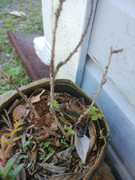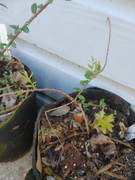Some interesting plants I have gotten into recently but don't see getting much discussion on here is Neotropical blueberries and particularly the Agapetes genus
I have a few here in Houston, and they appear to do fine with the weather here although I cant imagine them liking the native soil-
As an epiphyte you can always do some really cool stump-pots with them though
The three I have established are
Agapetes oblonga “Yunnan Huckleberry”
Rare larger species 3–10′ tall. Fuzzy stems, oblong-lanceolate leaves. New growth is lustful pink-red. Develops a large woody caudex to 20″+. Very floriferous with tubular carmine-red flowers borne along the stems. Sweet edible berries, translucent white-pink with tiny hairs. Epiphytic in the evergreen forests of Yunnan, China up to 9000′. Surface sow the seed and keep warm to sprout. Z8b/9a? Text sourced from sacredsucculents.com

Agapetes serpens “Khursani” “Himalayan Lantern Huckleberry”
Epiphytic evergreen shrub to 2–3’+. Graceful arching braches arising from a woody caudex to 18″+. Shocking rose-red lantern-like flowers dangle from the branches, a flamboyant display that appeals equally to hummingbirds and primates. Lavender colored sweet edible berries. Native to the Himalayan mid elevation cloud forests, up to about 9,000′. The caudex of some species is edible. Prefers part shade, well draining acid soil and regular moisture. Fruits best when cross pollinated with another clone or species. Rooted cuttings. Z8b. Text sourced from sacredsucculents.com

Agapetes ‘Ludgvan’s Cross’ “Himalayan Huckleberry Hybrid”
A hybrid of A. serpens and A. rugosa, forming a 3–4’+ shrub. 2–3″ pointed leaves and eventually deveolops a gnarled woody caudex. Pale-pink lantern flowers with deep rose chevron markings are borne in mass along the stems, a sight to see! Weird, marble size, translucent white-pink to purple edible berries. Hummingbirds love Agapetes. Part shade, well draining acid soil. Rooted cuttings. Z8b Text sourced from sacredsucculents.com

I left them all uncovered this year and the oblonga took a bit of a hit but the others seem to be doing quite well, so I ordered these other three
Agapetes aff. cauliflora SEH27042 “Vietnamese Huckleberry”
Ericaceae. Evergreen caudiciform with long arching branches to 3’+ . Hairy stems and lanceolate evergreen leaves, blue-green when young. Clusters of white tubular flowers with green tips, red edible berries. Native to the cloud forests of Vietnam. May be intermediate to the larger growing A. malipoensis. Our first offering of this rare species. Rooted cutting. Z8/9?
Text sourced from sacredsucculents.com
Agapetes hosseana “Saphaolom” “Thai Huckleberry”
Ericaceae. A lovely blueberry relative that forms large woody caudiciform lignotubers. Arching branches to 3'+ with shiny, rounded-elliptic, evergreen
leaves. Clusters of pendant, narrow tubular red flowers with green tips. Sweet edible berries, white to pale pink with lavender speckles. An epiphytic
species native to the mountain forests of northern Thailand. The lignotubers are used in Thai medicine for nourishment after a fever. The tubers have
exhibited anticancer poperties. The plant contains triterpenes and steroidal compounds with antibacterial and antimalarial activity. Part shade and a fast
draining acidic soil. Does well in hanging baskets. Surface sow seeds warm. Z9a
Text sourced from sacredsucculents.com
Agapetes smithiana v. major “Yellow Flowered Himalayan Huckleberry”
Woody caudiciform lignotubers, long arching branches with rounded leaves. Dark yellow tubular flowers hang from the stems in clusters. Edible berries.
An beautiful endangered native of the mid elevation cloud forests of the western Himalaya where it occurs primarily as an epiphyte. Well draining acidic
soil, part shade. Rooted cuttings.Z8b/9a
Text sourced from sacredsucculents.com